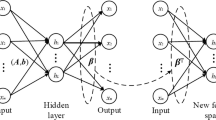Abstract
As a single learner, extreme learning machine autoencoder (ELM-AE) and generalized extreme learning machine autoencoder (GELM-AE) have limited ability to learn high-dimensional complex data features because high-dimensional data contains more complex and rich discriminative information. GELM-AE only pays attention to the internal relationship of each data subset for dimensionality reduction, ignoring the relationship between different subsets. This paper proposes the homogeneous ensemble extreme learning machine autoencoder (HeELM-AE) to extract high-dimensional complex data diversity features. This method combines the ideas of ensemble feature learning and mutual representation matrix learning. Multiple data subsets are constructed from the original high-dimensional complex dataset with feature learning methods. Generalized extreme learning machine autoencoder(GELM-AE) is used as a base dimension reducer to learn rich discriminative information from highly redundant features. Mutual representation learning methods can characterize correlations between different data subsets and the local manifold structure inherent in different data subsets is maintained through manifold regularization at the same time. Extensive comparative experiments on medical datasets show that compared with other ensemble feature learning models, HeELM-AE is an efficient and accurate model. Finally, visual analysis is used to explain the working mechanism of each stage of HeELM-AE and explore feature learning model interpretability.

















Similar content being viewed by others
References
Tang C, Liu X, Li M, Wang P, Chen J, Wang L, Li W (2018) Robust unsupervised feature selection via dual self-representation and manifold regularization. Knowl Based Syst 145:109–120. https://doi.org/10.1016/j.knosys.2018.01.009
Luo T, Yang Y, Yi D, Ye J (2017) Robust discriminative feature learning with calibrated data reconstruction and sparse low-rank model. Appl Intell:1–14. https://doi.org/10.1007/s10489-017-1060-7
Chen T, Guo Y, Hao S (2020) Unsupervised feature selection based on joint spectral learning and general sparse regression. Neural Comput Appl 32(11):6581–6589. https://doi.org/10.1007/s00521-019-04117-9
Zhang Y, Zhang Z, Li S, Qin J, Liu G, Wang M, Yan S (2019) Unsupervised nonnegative adaptive feature extraction for data representation. IEEE Trans Knowl Data Eng 31(12):2423–2440. https://doi.org/10.1109/TKDE.2018.2877746
Koohzadi M, Charkari NM, Ghaderi F (2020) Unsupervised representation learning based on the deep multi-view ensemble learning. Appl Intell 50(2):562–581. https://doi.org/10.1007/s10489-019-01526-0
Lu J, Wang H, Zhou J, Chen Y, Lai Z, Hu Q (2021) Low-rank adaptive graph embedding for unsupervised feature extraction. Pattern Recognit 113:107758. https://doi.org/10.1016/j.patcog.2020.107758
Wang R, Bian J, Nie F, Li X (2022) Unsupervised discriminative projection for feature selection. IEEE Trans Knowl Data Eng 34(2):942–953. https://doi.org/10.1109/TKDE.2020.2983396
Chen D, Lv J, Yi Z (2018) Graph regularized restricted boltzmann machine. IEEE Trans Neural Netw Learn Syst 29(6):2651–2659. https://doi.org/10.1109/TNNLS.2017.2692773
Zhang N, Sun S (2021) Multiview graph restricted boltzmann machines. IEEE Trans Cybern:1–15
Feng S, Duarte MF (2018) Graph autoencoder-based unsupervised feature selection with broad and local data structure preservation. Neurocomputing 312:310–323. https://doi.org/10.1016/j.neucom.2018.05.117
Wang X, Wang Z, Zhang Y, Jiang X, Cai Z (2022) Latent representation learning based autoencoder for unsupervised feature selection in hyperspectral imagery. Multim Tools Appl 81(9):12061–12075. https://doi.org/10.1007/s11042-020-10474-8
Gong X, Yu L, Wang J, Zhang K, Bai X, Pal NR (2022) Unsupervised feature selection via adaptive autoencoder with redundancy control. Neural Netw 150:87–101. https://doi.org/10.1016/j.neunet.2022.03.004
Yu J (2019) Manifold regularized stacked denoising autoencoders with feature selection. Neurocomputing 358:235–245. https://doi.org/10.1016/j.neucom.2019.05.050
Hui Y, Zhao X (2020) Sparse representation preserving embedding based on extreme learning machine for process monitoring. Trans Inst Meas Control 42(10):1895–1907. https://doi.org/10.1177/0142331219898937
Liu T, Kasun LLC, Huang G, Lin Z (2018) Extreme learning machine for joint embedding and clustering. Neurocomputing 277:78–88. https://doi.org/10.1016/j.neucom.2017.01.115
Shao L, Kang R, Yi W, Zhang H (2021) An enhanced unsupervised extreme learning machine based method for the nonlinear fault detection. IEEE Access 9:48884–48898. https://doi.org/10.1109/ACCESS.2021.3068959
Zhang H, Deng X, Zhang Y, Hou C, Li C, Xin Z (2019) Nonlinear process monitoring based on global preserving unsupervised kernel extreme learning machine. IEEE Access 7:106053–106064. https://doi.org/10.1109/ACCESS.2019.2932017
Chen J, Zeng Y, Li Y, Huang G (2020) Unsupervised feature selection based extreme learning machine for clustering. Neurocomputing 386:208–220. https://doi.org/10.1016/j.neucom.2019.12.065
Kasun LLC, Yang Y, Huang G, Zhang Z (2016) Dimension reduction with extreme learning machine. IEEE Trans Image Process 25(8):3906–3918. https://doi.org/10.1109/TIP.2016.2570569
Sun K, Zhang J, Zhang C, Hu J (2017) Generalized extreme learning machine autoencoder and a new deep neural network. Neurocomputing 230:374–381. https://doi.org/10.1016/j.neucom.2016.12.027
Ouyang T (2021) Feature learning for stacked ELM via low-rank matrix factorization. Neurocomputing 448:82–93. https://doi.org/10.1016/j.neucom.2021.03.110
Chen L, Honeine P, Qu H, Zhao J, Sun X (2018) Correntropy-based robust multilayer extreme learning machines. Pattern Recogn 84:357–370. > https://doi.org/10.1016/j.patcog.2018.07.011
Chen X, Wang Q, Zhuang S (2021) Ensemble dimension reduction based on spectral disturbance for subspace clustering. Knowl Based Syst 227:107182. https://doi.org/10.1016/j.knosys.2021.107182
Chen X, Liao M, Ye X (2017) Projection subspace clustering. J Algorithms Comput Technol 11(3):224–233. https://doi.org/10.1177/1748301817707321
Liu Z, Wang J, Liu G, Pu J (2019) Sparse low-rank preserving projection for dimensionality reduction. IEEE Access 7:22941–22951. https://doi.org/10.1109/ACCESS.2019.2893915
Acknowledgements
This research was supported by National Natural Science Foundation of China (Grant No.11571074) and Natural Science Foundation of Fujian Province, China (Grant No. 2022J01102).
Author information
Authors and Affiliations
Corresponding author
Additional information
Publisher’s note
Springer Nature remains neutral with regard to jurisdictional claims in published maps and institutional affiliations.
Rights and permissions
Springer Nature or its licensor (e.g. a society or other partner) holds exclusive rights to this article under a publishing agreement with the author(s) or other rightsholder(s); author self-archiving of the accepted manuscript version of this article is solely governed by the terms of such publishing agreement and applicable law.
About this article
Cite this article
Chen, W., Chen, X. & Lin, Y. Homogeneous ensemble extreme learning machine autoencoder with mutual representation learning and manifold regularization for medical datasets. Appl Intell 53, 15476–15495 (2023). https://doi.org/10.1007/s10489-022-04284-8
Accepted:
Published:
Issue Date:
DOI: https://doi.org/10.1007/s10489-022-04284-8




